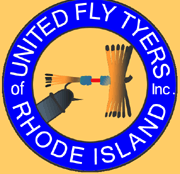United Fly Tyers of Rhode Island, Inc.
Insert Headline
November Newsletter
CDC Caddis Fly
Cook's Shrimp Pattern
People who have fished with the Dutch fly tying wizard Hans Weilenmann will undoubtedly have met the CDC & Elk. This is Hans' signature fly and probably his all time favorite fly. It's also a fly, which a lot of anglers have learned to love, including myself.
Advantages
I probably don't need to emphasize the advantages of this fly, but I will do so anyhow in a very short, annotated list:
few materials (three actually, thread, CDC feather, deer hair)
easy to tie (few tying steps and few turns of thread)
durable (fish can trash it, though!)
floats like a cork (both the materials are willing floaters, and floatant can add to that)
good imitation (mainly of caddis, but probably does look like a lot of other things to a fish)
+
The original
Hans Weilenmann
In every way a true classic, and this article is my tribute to the fly and its originator.
Brooks Blond Striper Fly
One might think that, as famous and influential a pattern as the Blonde is in the fly fishing lexicon, we would have an equally well-documented genesis and history. After all, we can trace the Adams dry fly all the way to Len Halladay and the very pool on the Boardman River in Michigan where it was first cast! There is no question about the true originator of the Quill Gordon. But the Blonde has some mystery, perhaps as every real blonde must.
In the 1966 edition of Joseph Bates’ book Streamer Fly Tying and Fishing, Bates writes “Joe Brooks’ “Blondes” in suitable sizes are excellent flies for tarpon, as well as other game fish. The Homer Rhode, Jr. Tarpon Bucktail illustrated in Figure VIII-3 probably was the father of this type, because Homer gave me some of them prior to 1950, and they were illustrated in Streamer Fly Fishing, which was first published at that time.”
On the key to the color plate that depicts the Argentine Blonde as representative of the “Brooks Blonde” Bates credits the fly as being “Originated by Mr. Homer Rhode and [emphasis added] Mr. Joe Brooks.”
In contrast, in the 1958 book Fly Fishing Brooks states “Many flies designed for fresh water have proven equally efficient in the salt, and conversely a number of streamers and bucktails designed for fishing the ocean flats have turned out to be highly effective in fresh water, especially for big trout and salmon. One big white bucktail, the platinum blonde, and an equally big fly made of yellow bucktail, called the honey blonde, have proven just about the best flies I have ever used for really big trout.”
“They were originally tied for striped bass and in an effort to make the fly large and extra long-winged, one piece of bucktail was tied on top of the 1/0 hook and immediately behind the eye, and another length of bucktail was tied just in front of the bend of the hook. It proved a very good number for stripers and that first fall after it was tied I also tried it in Montana for big browns and rainbows. It worked like a charm and I came up with some nice fish, from 3 to 7 pounds.”
Steve Cook will tye his version of the very popular Shrimp Pattern.
He will use the following materials:
Grizzly Soft Hackle
Olive Bucktail
Olive thread
Olive Mallard Flank
Jungle Cock or Pheasant Back
Elk Mane or Peccary
This is a very effective fly pattern that every fisherman should have in his arsenal.






